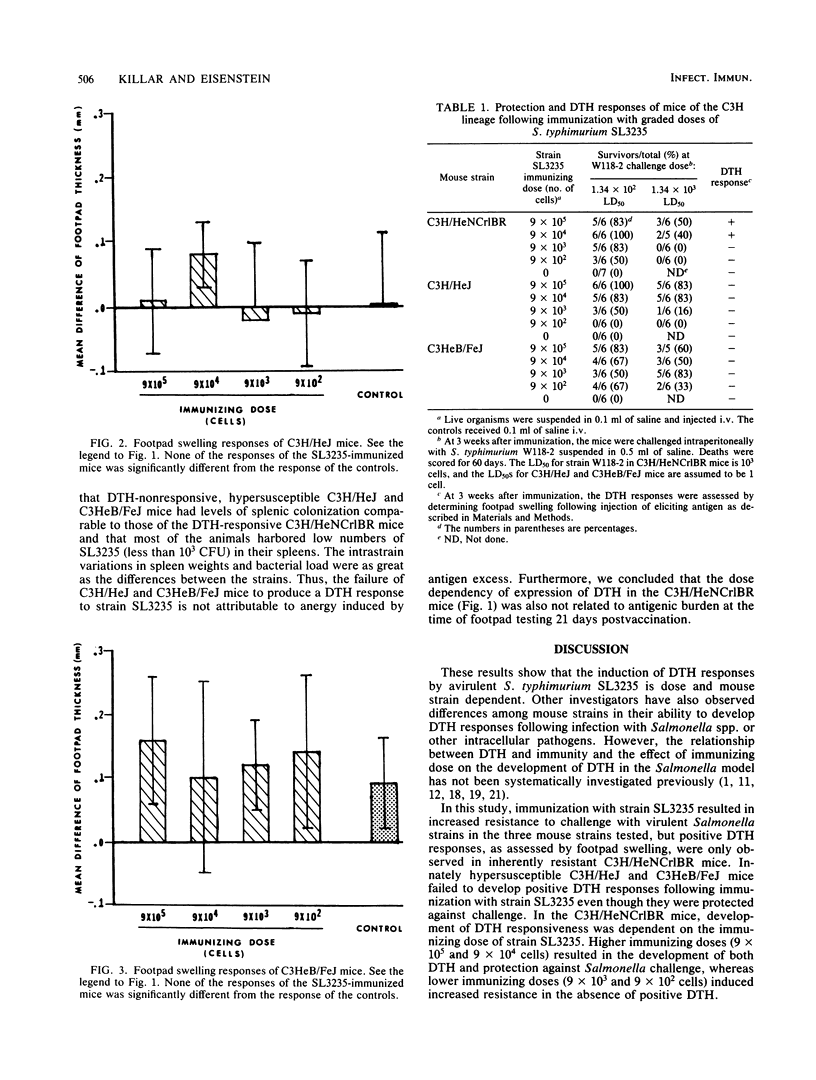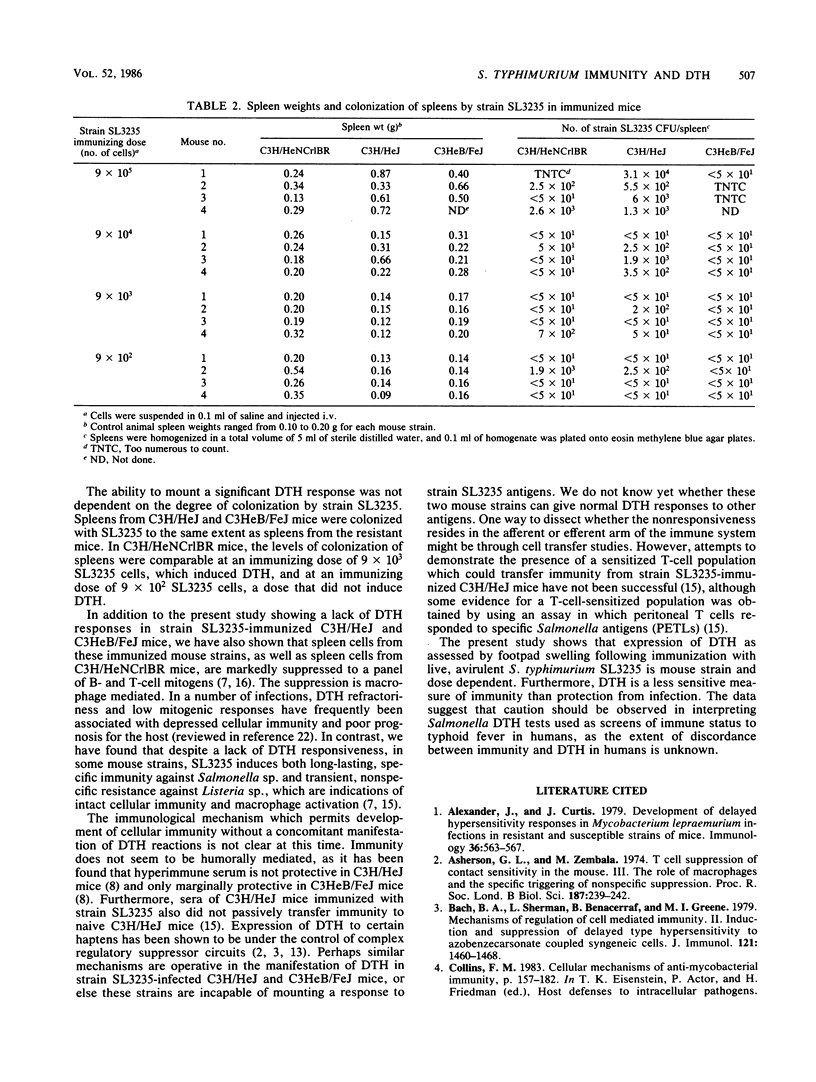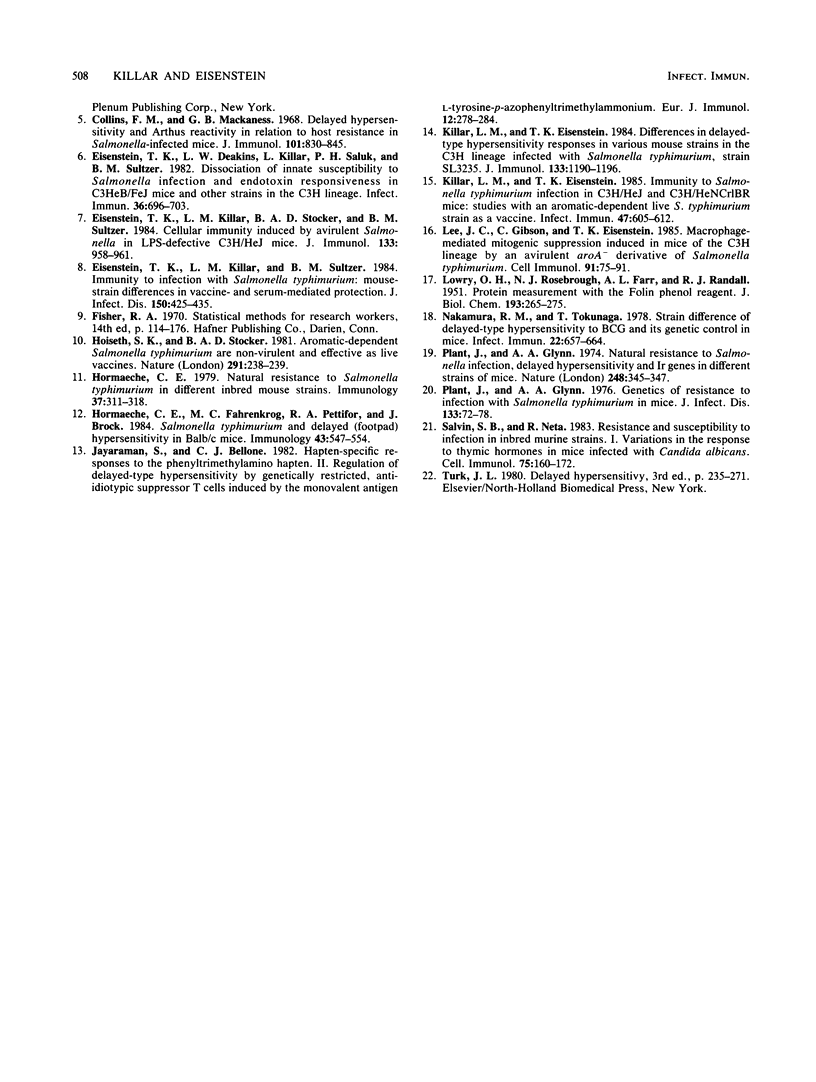Abstract
Studies were carried out to correlate immunity and expression of delayed-type hypersensitivity (DTH) in mice of the C3H lineage immunized with an avirulent strain of Salmonella typhimurium (strain SL3235). This strain belongs to a class of aroA- organisms which are being considered as vaccine strains for humans and veterinary use. In a systematic study, the relationship between the mouse strain and the immunizing dose of strain SL3235 on the development of protective immunity and DTH was examined. It was found that in hypersusceptible C3H/HeJ and C3HeB/FeJ mice, several doses of strain SL3235 afforded protection against intravenous challenge doses as high as 1,300 50% lethal doses. Despite these significant levels of immunity to challenge, mice of these two strains never mounted significant DTH responses following immunization with the doses of strain SL3235 tested, which spanned 3 orders of magnitude. Nonresponsiveness was not due to antigen overload, as all of the mouse strains were comparably colonized with strain SL3235 at the time of DTH elicitation. Further, it was found that the ability of responsive C3H/HeNCrlBR mice to display DTH was dependent on the immunizing dose of strain SL3235 and that a dosage could be found that resulted in increased resistance to challenge in these mice without a concomitant display of DTH. Thus, while both induction of protective immunity and DTH were vaccine dosage dependent in the responsive mouse strain (C3H/HeNCrlBR), DTH was a less sensitive measure of protective immunity than survival. Vaccine dosages ranging over three orders of magnitude failed to yield positive footpads to the Salmonella elicitin in the nonresponsive mice. The data suggest that caution should be observed in interpreting Salmonella DTH tests that are used as screens of immune status to typhoid fever in humans, as the extent of discordance between immunity and DTH in humans is unknown.
Full text
PDF




Selected References
These references are in PubMed. This may not be the complete list of references from this article.
- Alexander J., Curtis J. Development of delayed hypersensitivity responses in Mycobacterium lepraemurium infections in resistant and susceptible strains of mice. Immunology. 1979 Mar;36(3):563–567. [PMC free article] [PubMed] [Google Scholar]
- Bach B. A., Sherman L., Benacerraf B., Greene M. I. Mechanisms of regulation of cell-mediated immunity. II. Induction and suppression of delayed-type hypersensitivity to azobenzenearsonate-coupled syngeneic cells. J Immunol. 1978 Oct;121(4):1460–1468. [PubMed] [Google Scholar]
- Collins F. M. Cellular mechanisms of anti-mycobacterial immunity. Adv Exp Med Biol. 1983;162:157–182. doi: 10.1007/978-1-4684-4481-0_16. [DOI] [PubMed] [Google Scholar]
- Collins F. M., Mackaness G. B. Delayed hypersensitivity and arthus reactivity in relation to host resistance in salmonella-infected mice. J Immunol. 1968 Nov;101(5):830–845. [PubMed] [Google Scholar]
- Eisenstein T. K., Deakins L. W., Killar L., Saluk P. H., Sultzer B. M. Dissociation of innate susceptibility to Salmonella infection and endotoxin responsiveness in C3HeB/FeJ mice and other strains in the C3H lineage. Infect Immun. 1982 May;36(2):696–703. doi: 10.1128/iai.36.2.696-703.1982. [DOI] [PMC free article] [PubMed] [Google Scholar]
- Eisenstein T. K., Killar L. M., Stocker B. A., Sultzer B. M. Cellular immunity induced by avirulent Salmonella in LPS-defective C3H/HeJ mice. J Immunol. 1984 Aug;133(2):958–961. [PubMed] [Google Scholar]
- Eisenstein T. K., Killar L. M., Sultzer B. M. Immunity to infection with Salmonella typhimurium: mouse-strain differences in vaccine- and serum-mediated protection. J Infect Dis. 1984 Sep;150(3):425–435. doi: 10.1093/infdis/150.3.425. [DOI] [PubMed] [Google Scholar]
- Hoiseth S. K., Stocker B. A. Aromatic-dependent Salmonella typhimurium are non-virulent and effective as live vaccines. Nature. 1981 May 21;291(5812):238–239. doi: 10.1038/291238a0. [DOI] [PubMed] [Google Scholar]
- Hormaeche C. E., Fahrenkrog M. C., Pettifor R. A., Brock J. Acquired immunity to Salmonella typhimurium and delayed (footpad) hypersensitivity in BALB/c mice. Immunology. 1981 Jul;43(3):547–554. [PMC free article] [PubMed] [Google Scholar]
- Hormaeche C. E. Natural resistance to Salmonella typhimurium in different inbred mouse strains. Immunology. 1979 Jun;37(2):311–318. [PMC free article] [PubMed] [Google Scholar]
- Jayaraman S., Bellone C. J. Hapten-specific responses to the phenyltrimethylamino hapten. II. Regulation of delayed-type hypersensitivity by genetically restricted, anti-idiotype suppressor T cells induced by the monovalent antigen L-tyrosine-p-azophenyltrimethylammonium. Eur J Immunol. 1982 Apr;12(4):278–284. doi: 10.1002/eji.1830120405. [DOI] [PubMed] [Google Scholar]
- Killar L. M., Eisenstein T. K. Differences in delayed-type hypersensitivity responses in various mouse strains in the C3H lineage infected with Salmonella typhimurium, strain SL3235. J Immunol. 1984 Sep;133(3):1190–1196. [PubMed] [Google Scholar]
- Killar L. M., Eisenstein T. K. Immunity to Salmonella typhimurium infection in C3H/HeJ and C3H/HeNCrlBR mice: studies with an aromatic-dependent live S. typhimurium strain as a vaccine. Infect Immun. 1985 Mar;47(3):605–612. doi: 10.1128/iai.47.3.605-612.1985. [DOI] [PMC free article] [PubMed] [Google Scholar]
- LOWRY O. H., ROSEBROUGH N. J., FARR A. L., RANDALL R. J. Protein measurement with the Folin phenol reagent. J Biol Chem. 1951 Nov;193(1):265–275. [PubMed] [Google Scholar]
- Lee J. C., Gibson C. W., Eisenstein T. K. Macrophage-mediated mitogenic suppression induced in mice of the C3H lineage by a vaccine strain of Salmonella typhimurium. Cell Immunol. 1985 Mar;91(1):75–91. doi: 10.1016/0008-8749(85)90033-4. [DOI] [PubMed] [Google Scholar]
- Nakamura R. M., Tokunaga T. Strain difference of delayed-type hypersensitivity to BCG and its genetic control in mice. Infect Immun. 1978 Dec;22(3):657–664. doi: 10.1128/iai.22.3.657-664.1978. [DOI] [PMC free article] [PubMed] [Google Scholar]
- Plant J., Glynn A. A. Genetics of resistance to infection with Salmonella typhimurium in mice. J Infect Dis. 1976 Jan;133(1):72–78. doi: 10.1093/infdis/133.1.72. [DOI] [PubMed] [Google Scholar]
- Plant J., Glynn A. A. Natural resistance to Salmonella infection, delayed hypersensitivity and Ir genes in different strains of mice. Nature. 1974 Mar 22;248(446):345–347. doi: 10.1038/248345a0. [DOI] [PubMed] [Google Scholar]
- Salvin S. B., Neta R. Resistance and susceptibility to infection in inbred murine strains. I. Variations in the response to thymic hormones in mice infected with Candida albicans. Cell Immunol. 1983 Jan;75(1):160–172. doi: 10.1016/0008-8749(83)90315-5. [DOI] [PubMed] [Google Scholar]


